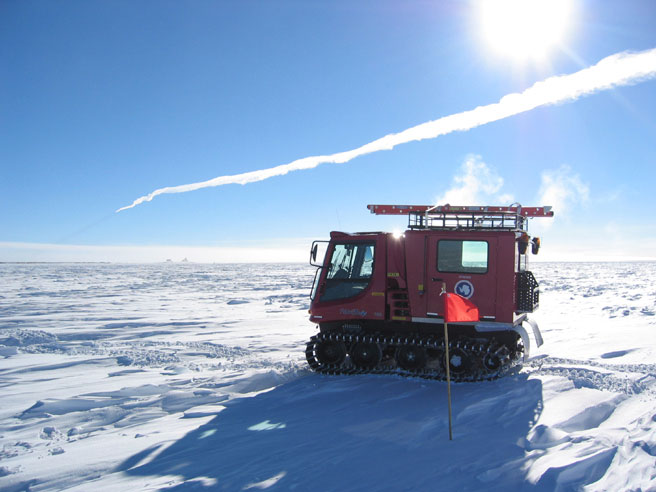

November at the Pole - Beginning of a Busy Season
In early November, the Station rapidly nears its summer capacity of
about 235 people. Work is continuing on the new Station while new
science projects are installed and continuing ones are upgraded. As
the Cusp Science Research Associate, I have 12 projects to operate and
maintain throughout the upcoming year. Summer is the time when the
principal investigators travel to the Pole anywhere from a few days to
a month to check on and upgrade the science projects creating a very
busy schedule. me and Al
at the pole
One of the first things done at skylab is to dig out the rear
door. Since skylab was built in the mid-1970's over 30 feet of
snow and ice have accumulated and drifted. Keeping the first floor door
open is a challenge now, particularly after a few days of heavy
winds. Al
digging in the sun back door snow steps
years of snow
accumulation
We also drove out to SPRESSO (South Pole Seismic Station) which is
the new USGS seismic vault. It has been placed about 5 miles out toward
grid East in the Quiet Sector of South Pole Station. The existing
seismic vault was merely several hundred meters from skylab making it
vulnerable to the many vibrations near the station caused primarily by
heavy equipment. digging out the hatch
for the under-ice SPRESSO vault me in the vault
Al climbing out of
the vault
Al and I went out to the Very Low Frequency (VLF) beacon transmitter
to check it out after the winter season. The VLF Beacon transmits a
signal at 19.4 kHz that bounces off the ionosphere and is received at
other stations such as Palmer Station on the coast of Antarctica. The
received signal reveals much about the electron precipitation region on
the ionosphere adding to information to help in the modeling of the
upper atmosphere and the magnetosphere of the earth. the Sloth vehicle that we
drove to VLF South Pole Station
almost 2 miles from VLF antenna under the center of the
7 kilometer-long dipole antenna . I
also went out to the Cusp antenna field that is about a kilometer about
grid north of skylab to check out everything after the long
winter. next
to the passive VLF receiver antenna
Antarctica experience a total solar eclipse on November 24, julian
date 328 at approximately 2220 Universal Coordinated Time (UTC). The
event lasted for almost two hours and it was about 86% total at the
geographic pole. eclipse
(-taken through dark filter)
panorama of polies
watching the start of the eclipse from the pole -
notice the two contrails left by 2 LC-130's on their way back to
McMurdo Station.
Finally, we celebrated Thanksgiving on Saturday with a great dinner.
It was the first of many holiday meals in the new elevated station. An
historic event. thanksgiving dinner
The National Geographic
television film crew has been here all week taking lots of footage. We
took them out to the VLF beacon antenna and they also filmed our fire
drill last week
A Real-Time Photo of South Pole Station as Seen from the ARO Building (live when satellite is up)
A Comprehensive
South Pole Web Site by Bill Spindler
Winterover Web Pages
(Bill Spindler's List)
SOUTH
POLE 2003-2004 HOME PAGE